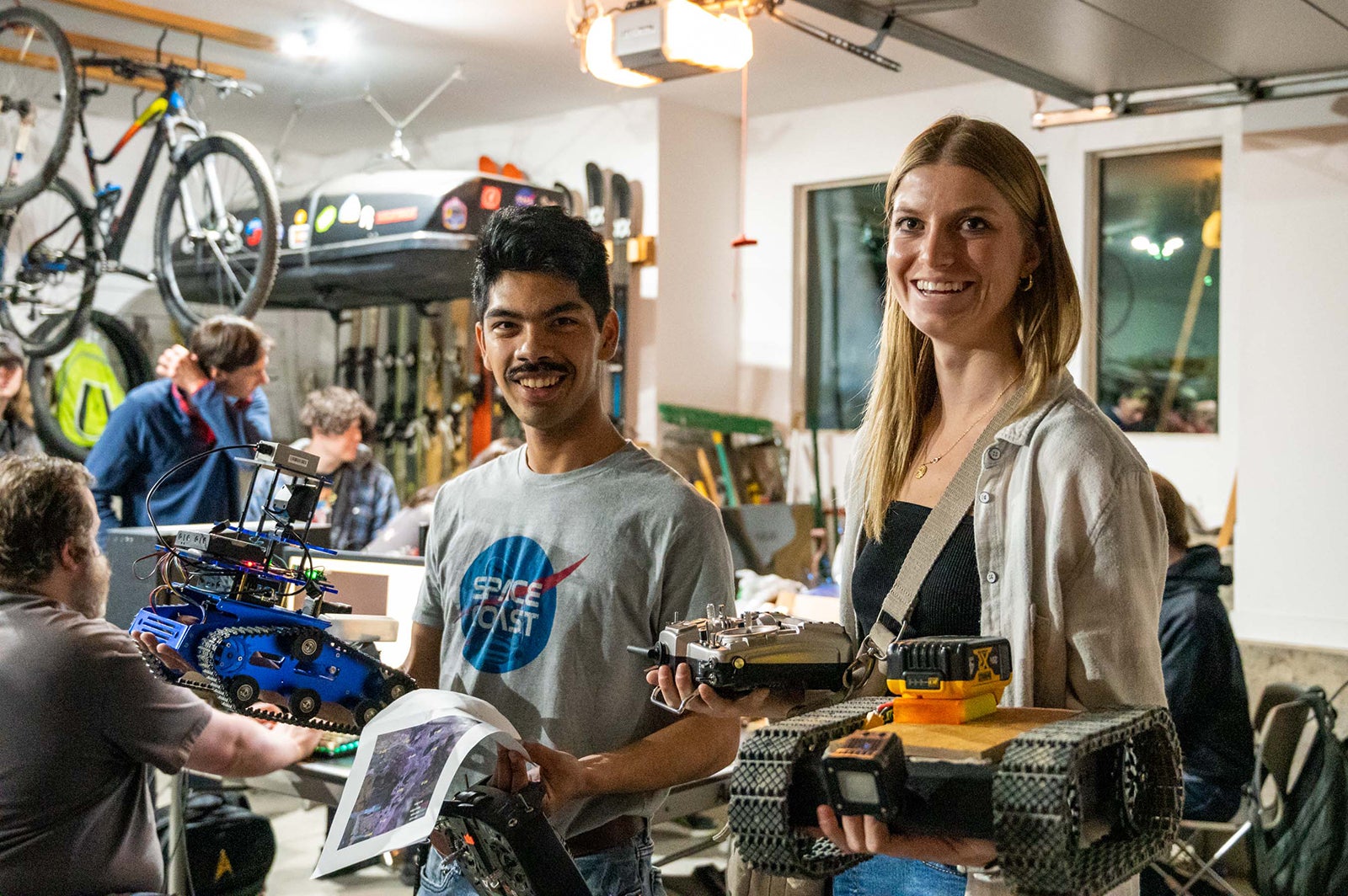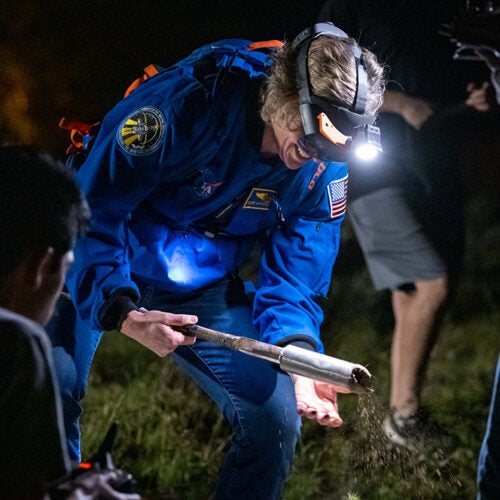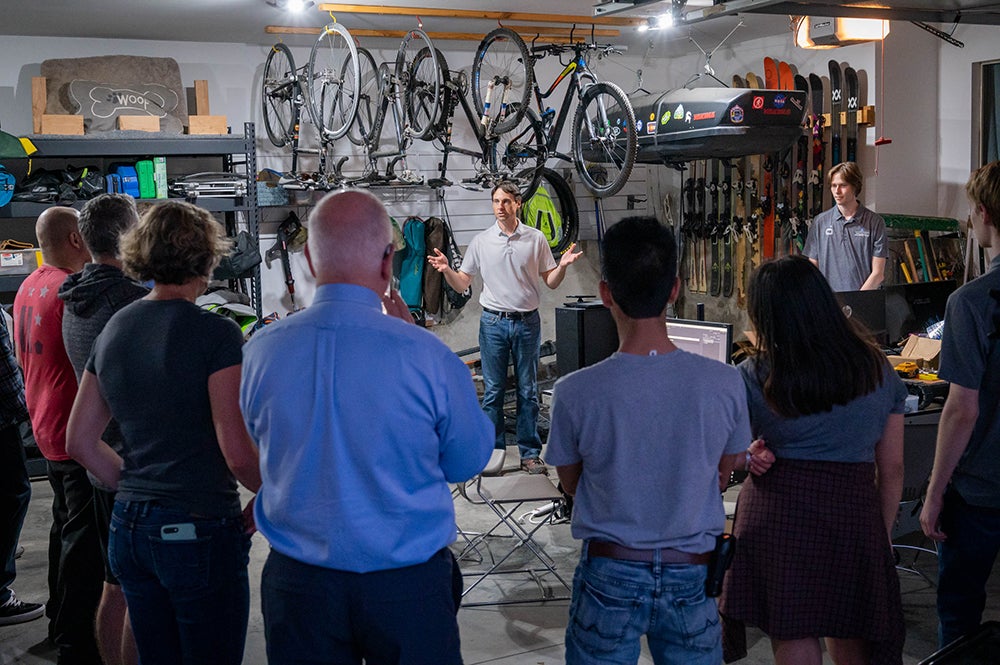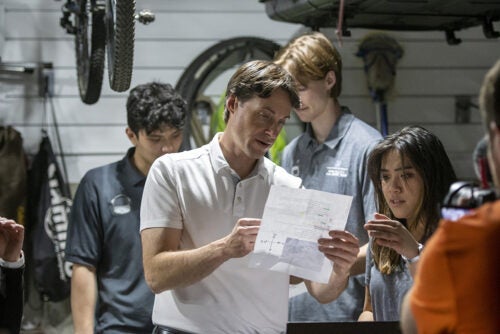
The simulated purpose of the EVA is to explore the area, and rocks therein, looking for geological features and rocks of interest, complete with soil samples.
Photo by Priscilla Grover
If you were going to create technology to be used by astronauts on the moon, where would you go to test it for that otherworldly experience? Your test site would need to be extremely dry and have volcanic materials, stark lighting conditions and a unique geology.
Hmm…wait, I’ve got it: Boise, Idaho!
In May 2023, members of Boise State’s NASA Spacesuit User Interface Technologies for Students (S.U.I.T.S) team, NASA Micro-g Neutral Buoyancy Experiment Design Teams (Micro-g NExT) and Autonomous Robotic Systems team developed an augmented reality display, an extended reality informatics system and used mini ‘moon rovers’ to test their capabilities for the upcoming Artemis missions to the south pole of Earth’s moon.
But get this: their technology was tested Reid Wiseman, a NASA astronaut and commander of the Artemis II mission, NASA astronaut Dottie Metcalf-Lindenburger and Greg Whitney, a NASA Flight Director.
Far out.

Landing on the Moon (in Steve’s Backyard)
On May 12, 2023, the students and NASA personnel met at the home of Boise State distinguished educator and retired astronaut Steve Swanson.
Traditionally, SUITS testing is carried out in Houston, Texas at Johnson Space Center. But this year, Swanson offered a new challenge to his students: to recreate the testing locally so that more students from other teams could participate and get hands-on experience working with real astronauts.
The challenge was met with a resounding ‘Yes.’
“In the Artemis missions that we’re going to start launching in 2024, the objective is to get humans on the south pole of the moon. We’re looking to start a long-term, sustained human presence to do research, to learn how to work off of the earth in the deep space environment,” said Wiseman.
So to make his backyard as moon-like as possible, Swanson and his students first worked to rig bright lights at eye-level to simulate the sun at a low angle on the lunar South Pole.

Photo by Priscilla Grover
During the fall and spring semesters, students in the SUITS project developed information displays using head mounted augmented reality devices, which superimpose digital information over a real environment to assist astronauts conducting spacewalks during NASA’s Artemis missions.
For astronauts conducting extravehicular activities (EVAs) on the moon–such as performing tech maintenance or collecting lunar geology samples for study–it is critical to test this technology in both harsh lighting and pitch black conditions to ensure the information is clearly visible to the astronauts, said Benedicto Villanueva, a junior in the Games, Interactive Media and Mobile Technology program.
“Given the extra light, it makes it harder for stuff to be seen in the HoloLens, or sometimes your gesture tracking isn’t as good as it is in a normally-lit environment,” Villaneuva said.
During the two-hour simulation, the astronauts wore the displays and followed the mission directives coming from Mission Control (Swanson’s garage-based team). They also used the Autonomous Robotic Systems team’s rovers to explore 100 square meters of terrain, and collect soil and rock samples, just as the first woman and first person of color will do in the upcoming Artemis missions.
Wiseman was impressed by the students’ ability to collect the astronauts’ feedback about strengths and flaws of their system and perfect their technology in real time.
“Dr. Swanson has got a great team out here,” Wiseman said. “It’s really neat to see these young students using their creativity, using their minds and using modern technology to rapidly prototype and iterate their design.”

At Mission Control (in Steve’s Garage)
Meanwhile in Swanson’s garage, NASA Flight Director Greg Whitney and the mission control student team offered directives to the astronauts outside, and incorporated challenges to test the technology’s limits and capabilities in a real operating environment.
“One of the things that I really think best describes mission control is just a team of problem solvers,” Whitney said. “Everyone has their technical area that they’re experts in, but they have to all come together and try to solve a common goal. I think one of the really important things to always remember is that everyone has something to bring to the team, and it’s really just trying to find that unique ability that will help make this whole thing successful.”

Senior GIMM major Trice Dayrit has been part of the NASA SUITS projects at Boise State for three and a half years now, but this was the first year that she took on the role of project manager. In doing so, she discovered her own unique ability that could make the whole team more successful.
“What’s been especially cool about NASA suits this year is people have really wanted to jump in. People would be texting me all the time asking ‘What do you want me to do? And I’d be like, ‘This is awesome! Everyone really wants to contribute.’ And for me, personally, I realized I want to be a project manager. I decided to start taking some project management classes at Boise State because of this,” Dayrit said.
“It’s been great to watch the team build and grow during this whole process,” said Swanson. “I’m really proud of this team, and I’m also happy they get to actually work with real NASA employees, astronauts, flight directors and experience what that’s like. I hope they take a little pride in the success of what they’ve worked on and what they’ve done.”

Fun Fact
This is not the first time astronauts have tested moon-mission skills and technology in Idaho. In August of 1969, astronauts from the Apollo 14 team traveled to Craters of the Moon, a national monument and preserve in southern Idaho, to simulate and practice the skills they would need for lunar exploration.